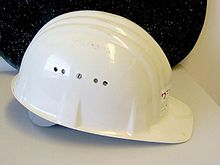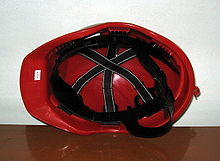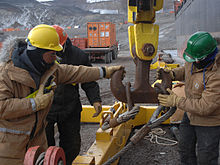- Hard hat
-
A hard hat is a type of helmet predominantly used in workplace environments, such as construction sites, to protect the head from injury by falling objects, impact with other objects, debris, bad weather and electric shock. Inside the helmet is a suspension that spreads the helmet's weight over the top of the head. It also provides a space of approximately 30 mm (1.2 inch) between the helmet's shell and the wearer's head so that if an object strikes the shell, the impact is less likely to be transmitted directly to the skull. Sometimes the helmet shell has a midline reinforcement ridge, which strengthens it against impact.
Contents
History
Management professor Peter Drucker credits writer Franz Kafka with developing the first civilian hard hat when he was employed at the Worker's Accident Insurance Institute for the Kingdom of Bohemia (1912), but this is not supported by any document from his employer.[1]
In the United States, the E.D. Bullard Company was a mining equipment firm in California, created by Edward Dickinson Bullard in 1898, who was in the industrial safety business for 20 years. The company sold protective hats, but they were only made of leather. His son, E.W. Bullard, arrived home from World War I with a steel helmet, which provided him with an idea to improve industrial safety. In 1919 Bullard patented a "Hard-Boiled Hat", made of steamed canvas, glue and black paint. That same year the U.S. Navy commissioned Bullard to create a shipyard protective cap, which began the widespread use of hard hats. Not long after, Bullard developed an internal suspension that would provide a more effective hat. These early designs bore a resemblance to the military M1917 "Brodie" helmet, which served as their inspiration.
In 1933 construction began on the Golden Gate Bridge in San Francisco California.[2] This was the second construction site in history where construction workers were required to wear hard hats (the first being the Hoover Dam project in 1931, as mandated by Six Companies, Inc), by order of Joseph Strauss, the project chief engineer. He wanted the workplace to be as safe as possible; hence, he installed safety nets and required hard hats while on the job site. Strauss also asked Bullard to create a hard hat to protect workers who performed sandblasting. Bullard produced a design that covered the worker's face, provided a window for vision and a supply of fresh air via a hose connected to the air compressor.
Aluminum became a standard for hard hats around 1938, except in electrical applications.
Fiberglass came into use in the 1940s.
Thermoplastics took over in the 1950s, because they were easy to mold and shape with heat and cost less to manufacture. Today, most hard hats are made from high-density polyethylene (HDPE) or advanced engineering resins, such as Ultem.
In 1997 ANSI allowed the development of a ventilated hard hat to keep wearers cooler. To it could be added accessories like face shields, sun visors, earmuffs, and perspiration-absorbing cloths which line the hats. Today, attachments include radios, walkietalkies, pagers, and cameras.
Design
Because hard hats are intended to protect the wearer's head from impacts where heavy labor is being performed, they are made from durable materials, originally from metal, then fiberglass, and most-commonly (from the 1950s onward) rigid plastic.
Some contemporary cap-style hard hats feature a rolled edge that acts like a rain gutter to channel rainwater to the front, allowing it to drain off the bill, instead of letting the water run down the wearer's neck. A cowboy hard hat is a hard hat shaped like a wide rimmed cowboy hat[3], although some organizations disallow their use.
Organizations issuing hard hats often include their names and/or logos (or some other message) on the front of each hard hat.
Hardhats may also be fitted with:
- Visor:
- As in a welding helmet, or
- A safety visor
- Ear protectors
- Mirrors for increased rear field-of-view
- A helmet light mount
- A chinstrap to keep the helmet from falling off if the wearer bends over
- Thick insulating side pads to keep the sides of the head warm in very cold places. Examples are seen in Ice Road Truckers.
Hard hat colors can signify different roles on construction sites. For instance, white might signify supervisors or engineers, blue technical advisors, red safety inspectors, and yellow laborers.
A hard hat also gives a worker a distinctive profile, identifiable even in peripheral vision, for safety around equipment or traffic. Safety colors like orange or green do not appear in peripheral vision, but the hard hatted shape of a worker will be avoided.
In 1997, the American National Standards Institute revised its performance standards for hard hats. Conformity to these standards and regulation are not necessary but almost all manufactures comply:
- ANSI Type I / CSA Type 1 hard hats meet stringent vertical impact and penetration requirements.
- ANSI Type II / CSA Type 2 hard hats meet both vertical and lateral impact and penetration requirements and have a foam inner liner of expanded polystyrene (EPS).
- A Class E hard hat has been proof-tested to insulate up to 20,000 volts of electrical potential.
- ANSI have compliance for hard hats and their combustibility or flammability criteria.
Blue-collar workers, especially union shop construction workers, engaged in occupations that require protective equipment are sometimes metonymically referred to as "hard hats".
A bump cap is a lightweight kind of hard hat with simplified suspension or padding in lieu of suspension and having only a chin strap. It is used where there is a possibility of scraping or bumping one's head on equipment or structure projections, but is not strong enough to absorb large impacts, such as from a tool dropped several stories.
Early on in the ship building industry workers would cover their hats with pitch (tar), and set them in the sun to cure. This was common practice for dock workers who were in constant danger of being hit on the head by objects being dropped from the deck of ships. There were also occasional items falling from the beaks of sea birds, who would pick up just about any item then drop it realizing that the object was inedible.
Gallery
-
Construction worker at Douglas Dam, Tennessee (TVA), 1942
-
The 2000-year-old remains of Ancient Rome, Italy, are being excavated by these archaeologists
See also
- Goggles
- Protective clothing
- Safety engineering
- Steel-toe boots
References
- ^ Drucker, Peter. Managing in the Next Society. See: Franz Kafka, Amtliche Schriften. Eds. K. Hermsdorf & B. Wagner (2004) (Engl. transl.: The Office Writings. Eds. S. Corngold, J. Greenberg & B. Wagner. Transl. E. Patton with R. Hein (2008)); cf. H.-G. Koch & K. Wagenbach (eds.), Kafkas Fabriken (2002).
- ^ a b Hoppe, Leslie (2004) "From the Hard-Boiled Hat to Today's Skull Bucket: A History of Hard Hats", Bullard Inc.
- ^ "Cowboy Hard Hat Inventor - Bret Atkins". http://cowboyhardhat.net/inventor-bret-atkins/. Retrieved 27-Sep-2010.
Categories:- Construction equipment
- Helmets
- Hats
- Safety clothing
- Visor:
Wikimedia Foundation. 2010.








